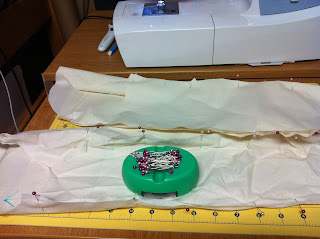Hello Internet world!
I'm really hungry for some ham. I love ham! Especially the glazed kind at Christmas, mmm! Well if you are now craving ham because I just said it, good! Because today we are talking about hams. Sorry, you can't eat these though. That might taste really gross. Have you ever heard of a ham for sewing? Don't worry, I hadn't either before I came to Baylor. My teacher said, "and now go to the iron and press this over a ham". I immediately thought:
I was extremely confused. Now why would I want to put fabric over this delicious meat and press it??? I was so silly back then. She meant a tailor's ham! Also called a pressing ham. And it's made of fabric and sawdust, not meat :) My parents thought the same thing when I told them I bought some hams at Joann's. "Do they sell food at Joann's now??" Oh, parents :) A pressing ham looks like this:
And as you probably guessed by the name, you use it to press things. Usually you put these under a fabric that needs rounding, in order to create space for the body underneath. Such as, but not limited to, a bust dart, sleeves, shoulders, etc. The ones that are actually ham shaped, like the one above, are usually used for bust darts. It gives the fabric a gentle curve. Here are some more hams that are used for different things:
The two on the left are called sleeve rolls, or seam rolls. I've heard it both ways. You use those in sleeves or pant legs in order to get the seams to lie flat. You would just put the ham underneath the fabric and then make sure the seams are flat, and then press. The curved ham is for more hard to reach places, or if you need a steeper curve. And the two on the right are normal hams. Here are some more gadgets used in pressing:
This is a sleeve board. It looks like a tiny ironing board, because it is. It's used when you have something small and awkward, like a sleeve, or maybe a baby's outfit, and can't fit it anywhere else; this is what you would use.
This is a clapper. Sounds weird, but it's pretty useful. Used to reduce fullness and bulk, usually with heavier fabrics. You press whatever you're doing, get the fabric warm, and then smack it with this! Good way to get aggression out :) Or you can just put pressure on it. It flattens puckering seams, and gives you a good, hard crease when you need it.
This is a collar board. The pointed end is used when you have to get down into the corner of a collar or a cuff, and gives you a stable surface to press on. This also gives you sharp edges and creases in collars, cuffs, and other small areas.
And here are the iron and the ironing board, these are of course, a must when pressing anything :) Hope you found this helpful!
Vivre la mode, tout le monde!










